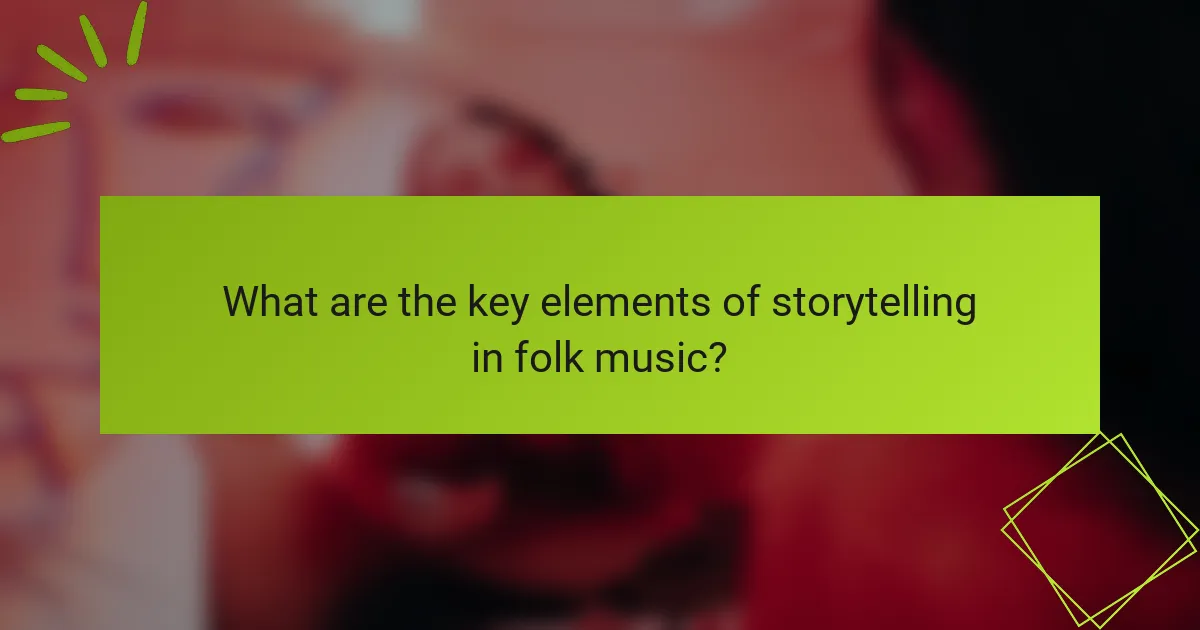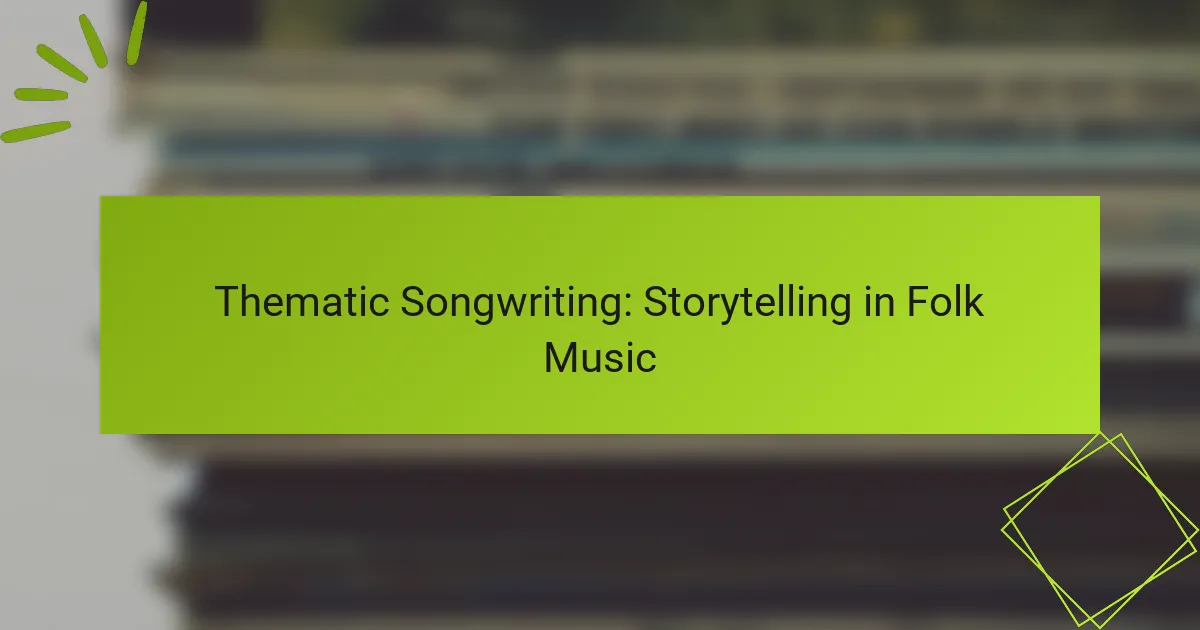Thematic songwriting in folk music is an art form that emphasizes storytelling, allowing artists to weave relatable narratives that connect with listeners on an emotional level. By incorporating vivid imagery and cultural references, songwriters create rich, immersive experiences that capture the essence of human experiences. Key elements such as character development and conflict resolution enhance the depth of these stories, making them resonate deeply with audiences.

How to write thematic songs in folk music?
Writing thematic songs in folk music involves crafting narratives that resonate with listeners through relatable stories and cultural references. Focus on emotional depth and vivid imagery to create a strong connection with your audience.
Focus on relatable narratives
Relatable narratives are the backbone of effective folk songs. They often reflect common experiences, struggles, or joys that many people can identify with, such as love, loss, or community. Consider drawing from personal experiences or local tales that evoke shared sentiments.
To enhance relatability, use first-person perspectives or familiar settings. For instance, a song about a small-town festival can evoke nostalgia and connection among listeners who have experienced similar events.
Incorporate cultural elements
Cultural elements enrich folk music by grounding it in specific traditions, values, and histories. This can include references to local customs, folklore, or even regional dialects. Incorporating these aspects helps to create a unique identity for your song.
Consider using traditional instruments or musical styles that reflect your cultural background. For example, a song featuring a banjo or fiddle can evoke the Appalachian folk tradition, while lyrics that reference local legends can deepen the cultural connection.
Use vivid imagery
Vivid imagery paints a picture in the listener’s mind, making the song more engaging and memorable. Use descriptive language to evoke sights, sounds, and emotions that transport the audience to the scene you are describing. For instance, instead of saying “the sun set,” you might say “the golden sun dipped below the horizon, casting a warm glow over the fields.”
Employ metaphors and similes to enhance your imagery. Comparing a feeling to a natural phenomenon, like saying “her heart raced like a river in spring,” can create a strong emotional impact and resonate with listeners.
Emphasize emotional connection
Emotional connection is crucial in folk music, as it allows listeners to feel the song’s message personally. Focus on themes that evoke strong feelings, such as longing, joy, or resilience. Authenticity in your lyrics and delivery can significantly enhance this connection.
Consider using repetition or a catchy chorus to reinforce emotional themes. This not only makes the song more memorable but also invites listeners to sing along, deepening their engagement with the music.

What are the key elements of storytelling in folk music?
Storytelling in folk music revolves around relatable narratives that convey emotions and experiences. Key elements include character development, conflict and resolution, and setting and atmosphere, all of which work together to create a compelling story that resonates with listeners.
Character development
Character development is crucial in folk music as it allows listeners to connect with the story on a personal level. Characters often embody universal traits or struggles, making them relatable to a wide audience. For example, a song may feature a weary traveler or a heartbroken lover, drawing listeners into their journey.
To enhance character development, songwriters can use vivid imagery and specific details that reveal the character’s background, motivations, and emotions. This helps to create a deeper understanding of the character’s journey and the choices they make throughout the song.
Conflict and resolution
Conflict and resolution are central to storytelling in folk music, providing the tension that drives the narrative forward. A song may present a dilemma, such as a lost love or a moral choice, which the character must confront. This conflict engages listeners and encourages them to invest emotionally in the outcome.
Effective resolution can take many forms, from a bittersweet ending to a triumphant conclusion. The way a songwriter resolves the conflict can leave a lasting impression, often reflecting broader themes of resilience or redemption that resonate with the audience.
Setting and atmosphere
The setting and atmosphere in folk music establish the backdrop against which the story unfolds. Descriptive language can evoke specific locations, such as a bustling village or a serene countryside, helping listeners visualize the scene. This grounding in place enhances the emotional weight of the story.
Creating a strong atmosphere can also involve the use of musical elements, such as tempo and instrumentation, which complement the narrative. For instance, a slow, mournful melody can amplify feelings of loss, while an upbeat rhythm might convey joy or celebration, enriching the storytelling experience.

Which folk artists excel in thematic songwriting?
Several folk artists are renowned for their thematic songwriting, weaving rich narratives that resonate deeply with listeners. Notable figures include Bob Dylan, Joan Baez, and Gillian Welch, each bringing unique storytelling techniques and perspectives to their music.
Bob Dylan
Bob Dylan is often regarded as a master of thematic songwriting, using vivid imagery and poignant lyrics to address social issues, personal experiences, and historical events. His songs, such as “The Times They Are a-Changin'” and “Blowin’ in the Wind,” illustrate complex themes of change and resistance.
Dylan’s approach often involves blending personal narrative with broader societal commentary, allowing listeners to connect with the music on multiple levels. His ability to craft songs that reflect the zeitgeist of various eras has made him a pivotal figure in folk music.
Joan Baez
Joan Baez is celebrated for her powerful voice and commitment to social justice, which she expresses through her thematic songwriting. Her songs often focus on themes of peace, love, and civil rights, as seen in tracks like “We Shall Overcome” and “Diamonds and Rust.”
Baez’s storytelling is characterized by emotional depth and a strong sense of activism, making her music not only entertaining but also a call to action. Her ability to convey heartfelt messages through her lyrics has solidified her place in the folk music tradition.
Gillian Welch
Gillian Welch excels in crafting songs that evoke a sense of nostalgia and explore themes of loss, love, and the American experience. Her work, including albums like “Revival” and “Time (The Revelator),” showcases her talent for storytelling through a blend of traditional folk and modern influences.
Welch’s songwriting often features rich, descriptive language and a focus on character-driven narratives, allowing listeners to immerse themselves in the stories she tells. Her unique style emphasizes the emotional weight of her themes, making her a standout artist in contemporary folk music.

What are effective songwriting techniques for folk music?
Effective songwriting techniques for folk music often emphasize storytelling, emotional resonance, and traditional forms. By focusing on relatable narratives and using established structures, songwriters can create compelling and memorable pieces that connect with audiences.
Use of traditional structures
Folk music frequently employs traditional song structures, such as verse-chorus formats or AABA forms. These familiar patterns help listeners engage with the story and anticipate the song’s progression. Incorporating elements like refrains or call-and-response can enhance the communal experience typical of folk performances.
Songwriters should consider using common time signatures, such as 4/4 or 3/4, which are prevalent in folk music. This familiarity allows for easier sing-alongs and a stronger connection to the audience. Additionally, utilizing simple chord progressions can keep the focus on the lyrics and melody.
Melodic storytelling
Melodic storytelling is central to folk music, where the melody complements the narrative conveyed in the lyrics. A strong melody can evoke emotions and enhance the listener’s connection to the story. Songwriters should experiment with varying melodic contours to reflect the song’s emotional highs and lows.
When crafting melodies, consider using motifs that represent specific characters or themes within the song. This technique can create a more immersive experience, allowing listeners to feel the journey of the story. Aim for melodies that are memorable yet simple enough for audiences to sing along.
Collaborative songwriting
Collaborative songwriting can bring diverse perspectives and ideas into folk music, enriching the storytelling process. Working with other musicians allows for the blending of different styles and influences, which can lead to innovative and engaging songs. Regular songwriting sessions can help foster creativity and accountability among collaborators.
When collaborating, establish clear roles and communication to ensure that everyone’s voice is heard. Consider using tools like shared documents or recording software to facilitate the creative process. Remember that collaboration should enhance the song, not dilute individual contributions, so maintain a balance between personal expression and group dynamics.

How does regional culture influence folk songwriting?
Regional culture significantly shapes folk songwriting by embedding local stories, traditions, and values into the music. This influence manifests through unique narratives, dialects, and historical references that resonate with the community’s identity.
Local history and legends
Folk songs often draw from the rich tapestry of local history and legends, telling stories that reflect the experiences and struggles of a community. For instance, songs about historical events, local heroes, or significant cultural milestones can evoke a sense of pride and belonging among listeners.
Incorporating these narratives not only preserves cultural heritage but also makes the music relatable. For example, a song about a famous battle or a legendary figure can serve as a reminder of the community’s resilience and values.
Regional dialects and language
Regional dialects and language play a crucial role in folk songwriting, adding authenticity and a sense of place to the music. Using local expressions and idioms can create a deeper connection with the audience, making the lyrics feel more personal and familiar.
For example, a folk song sung in a specific dialect can evoke nostalgia and pride among local listeners, while also educating outsiders about the culture. Songwriters should aim to incorporate these linguistic elements thoughtfully, ensuring they enhance the storytelling without alienating broader audiences.

